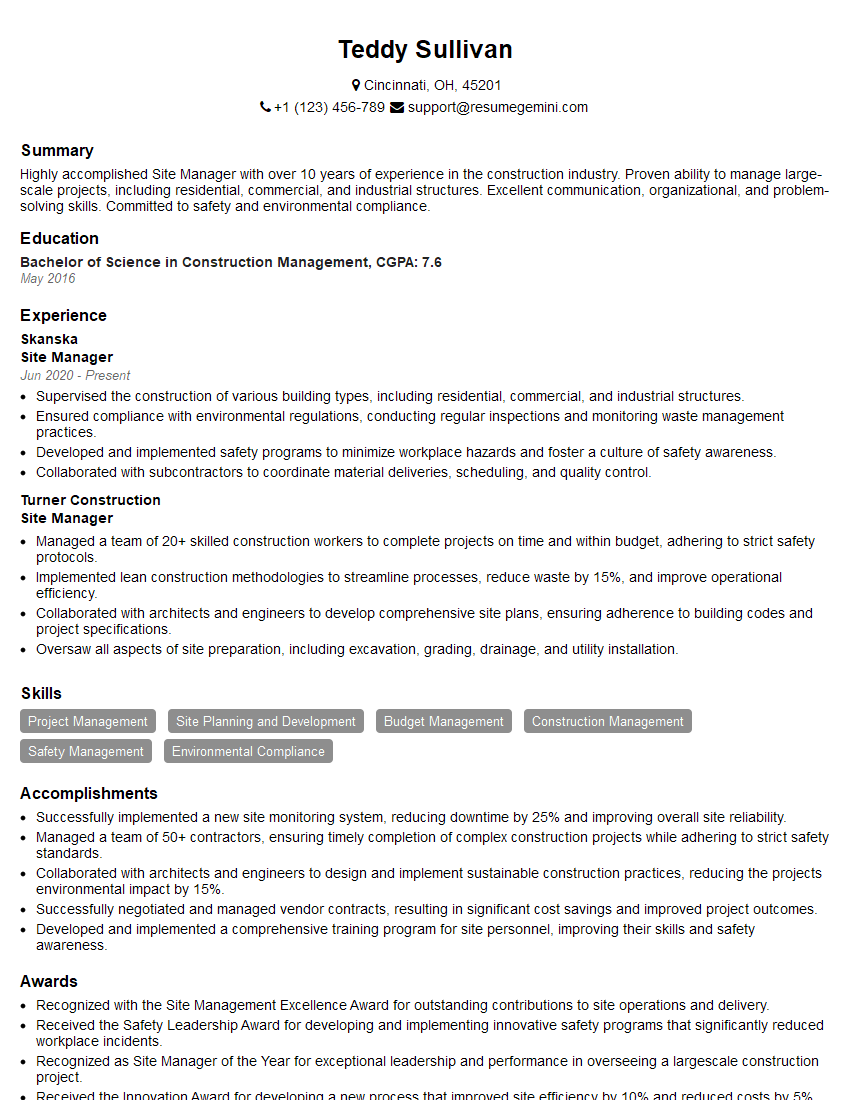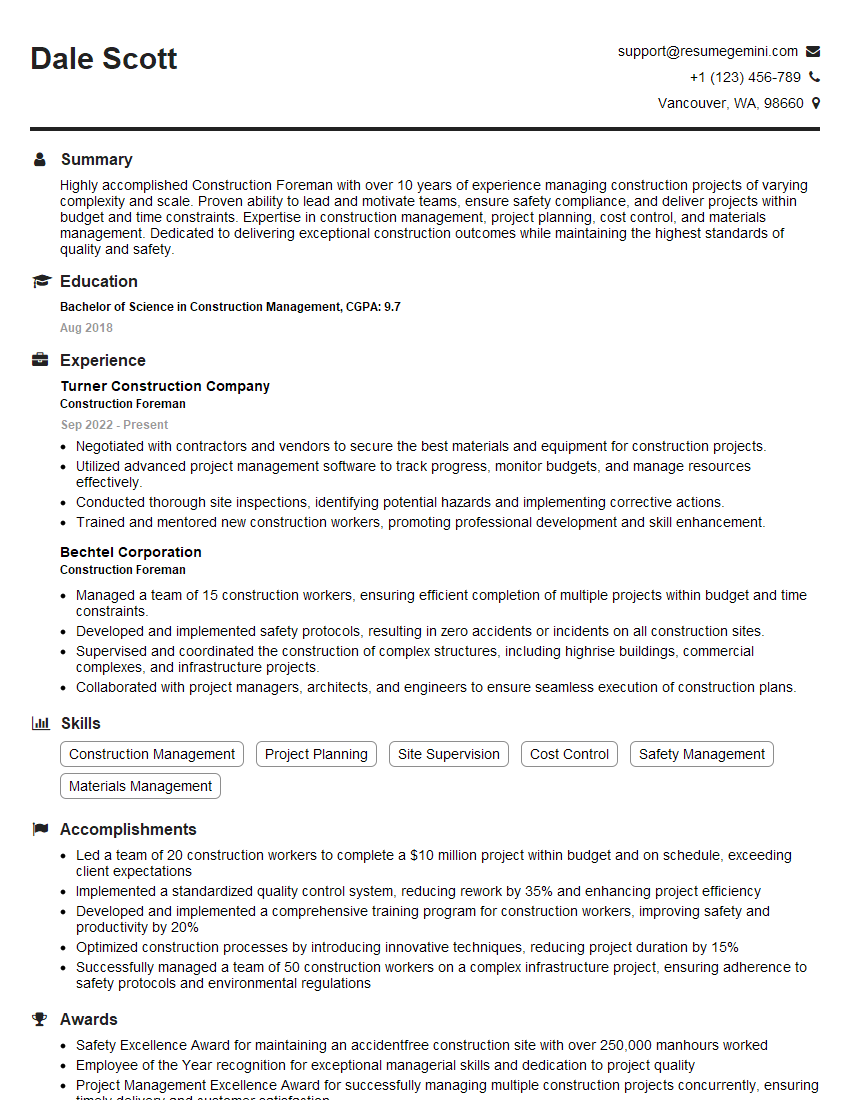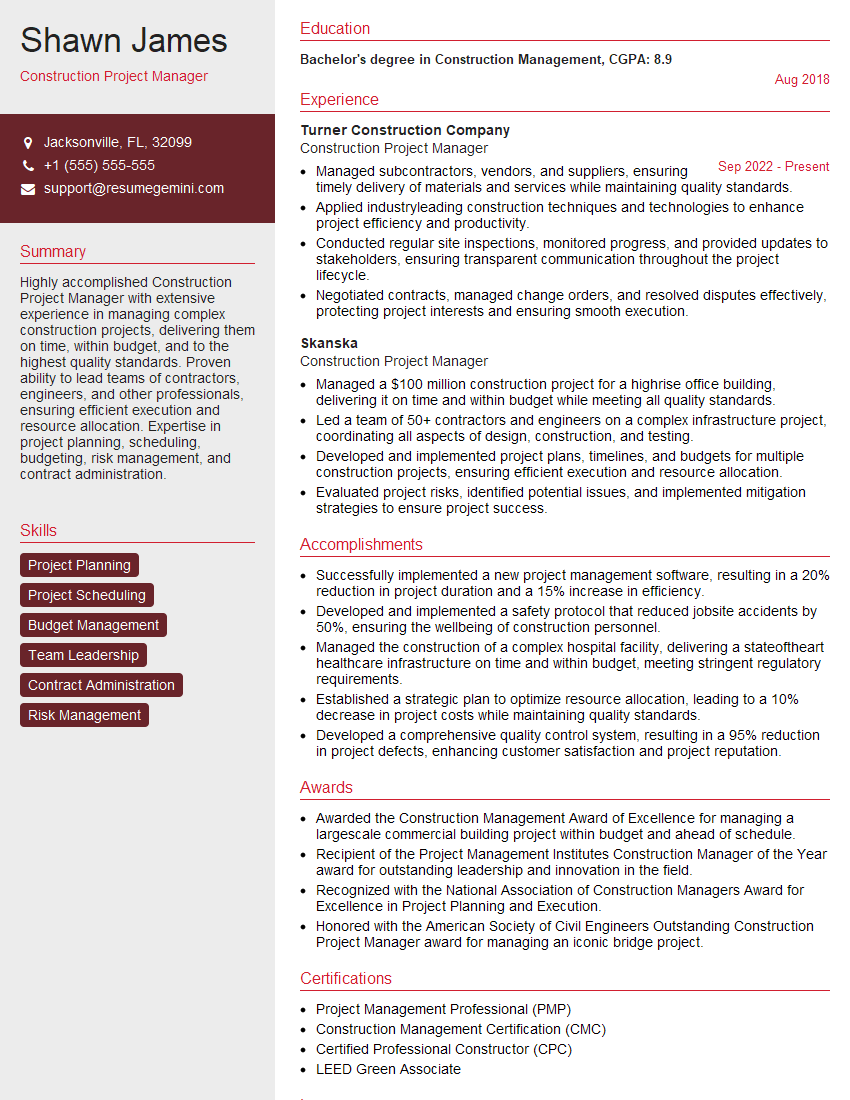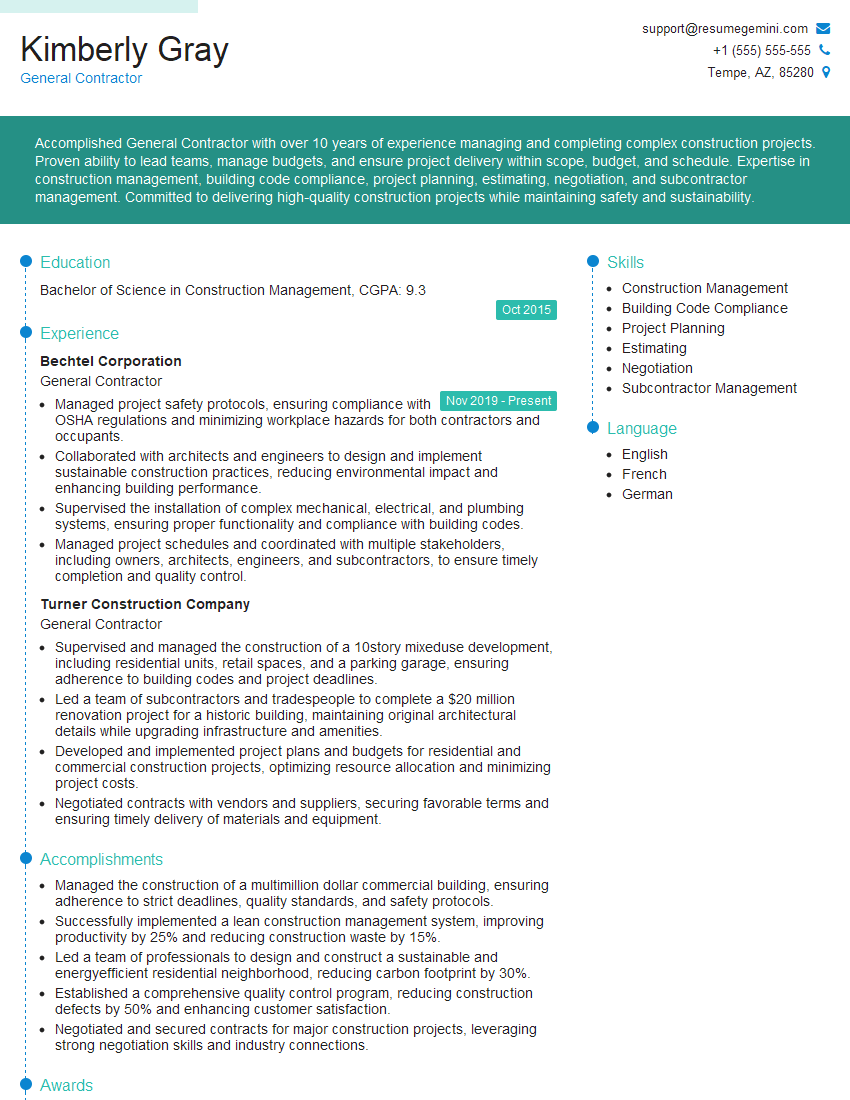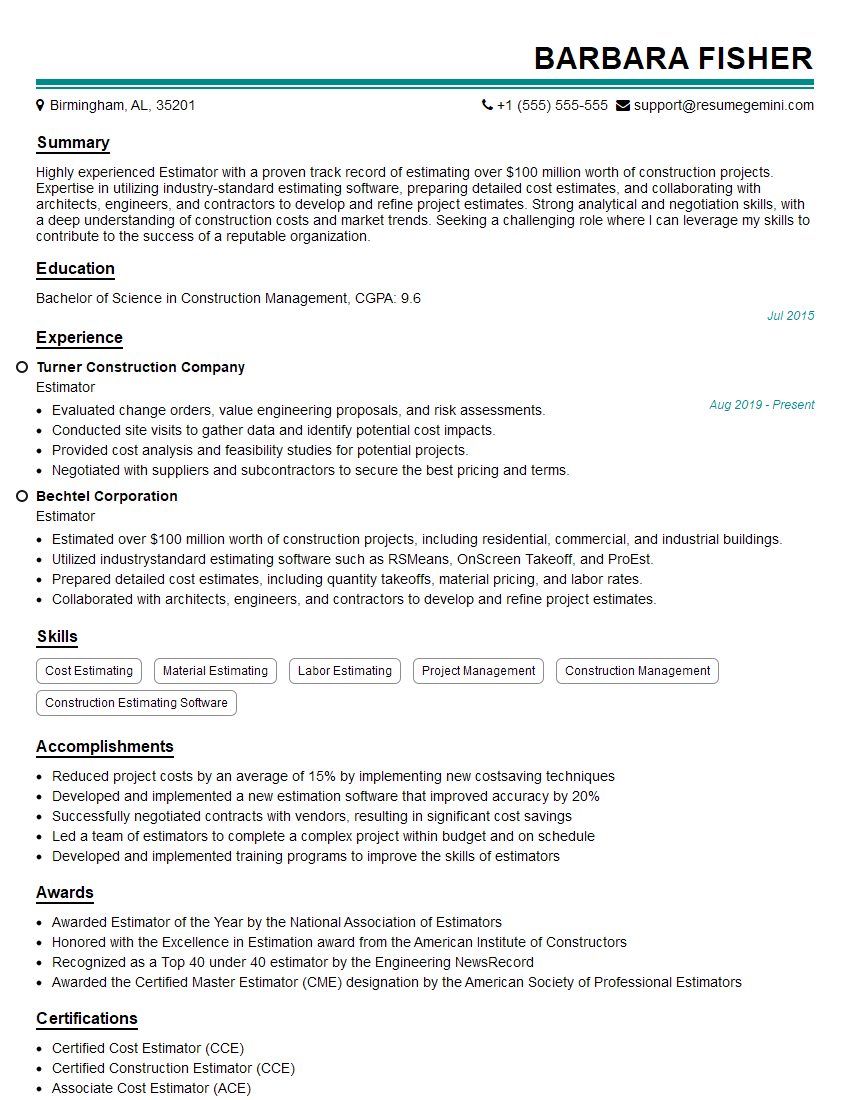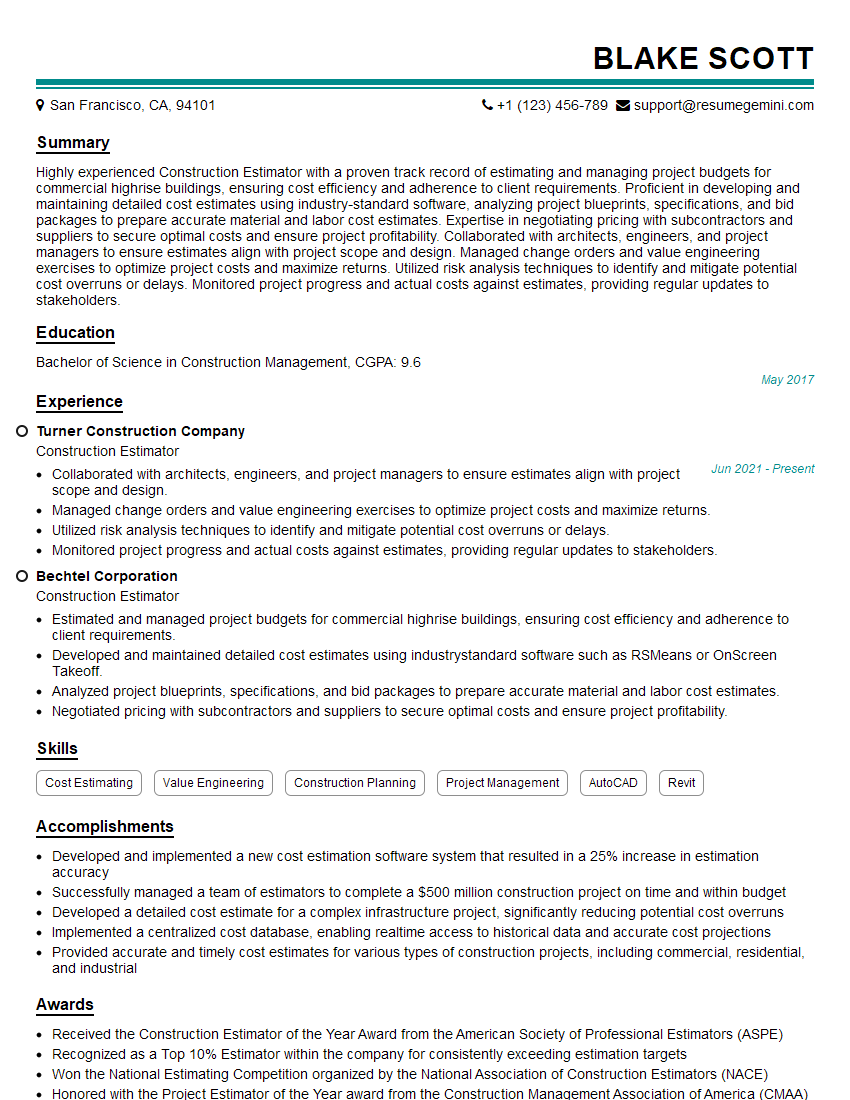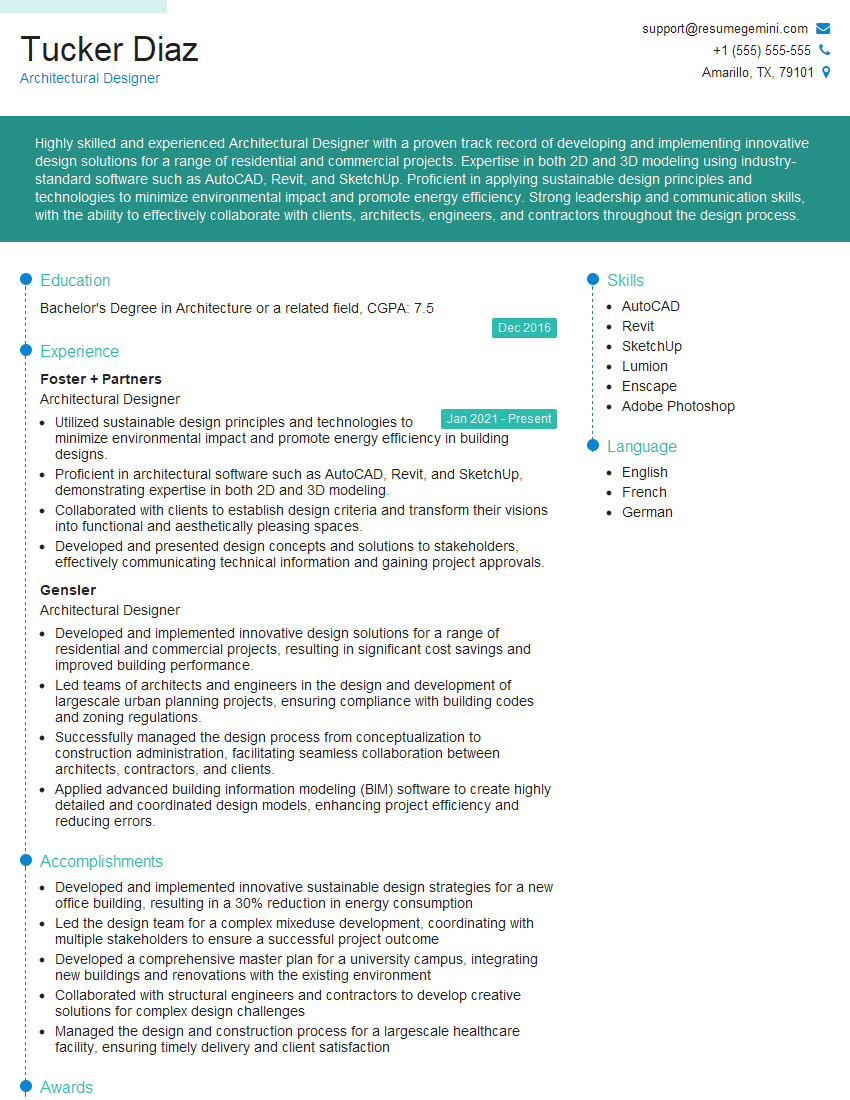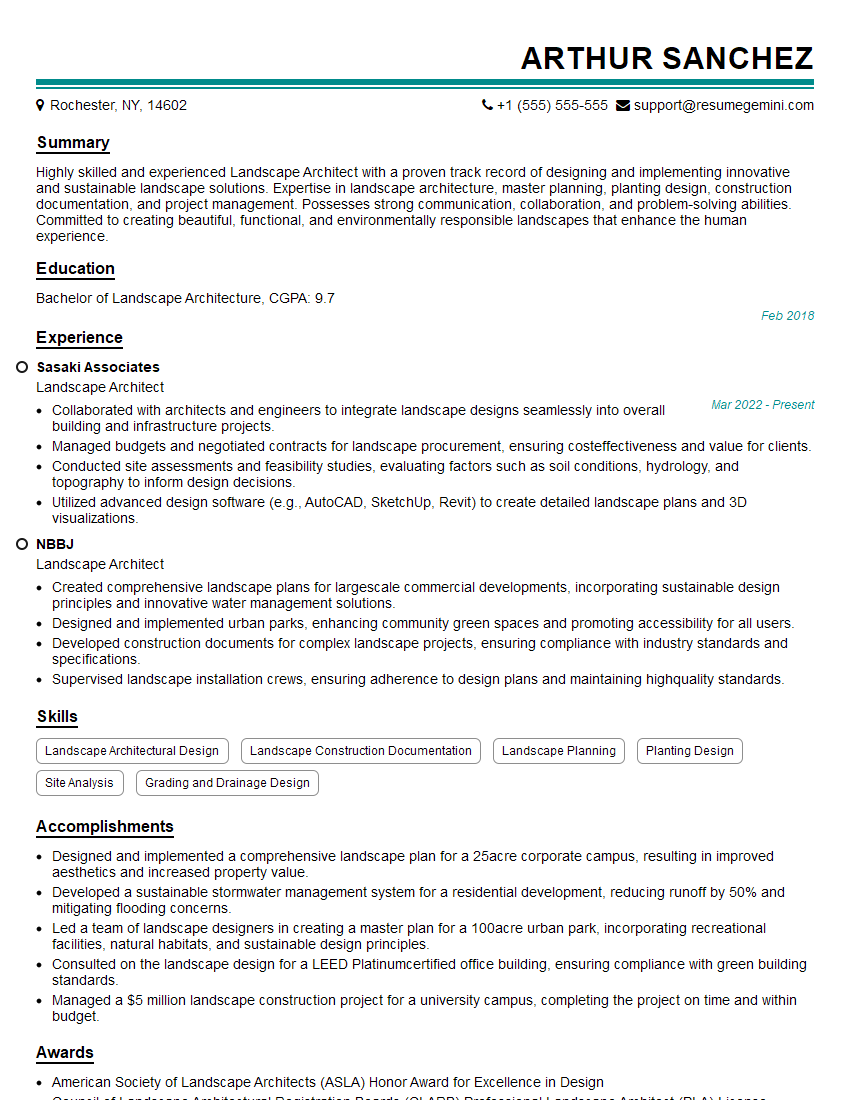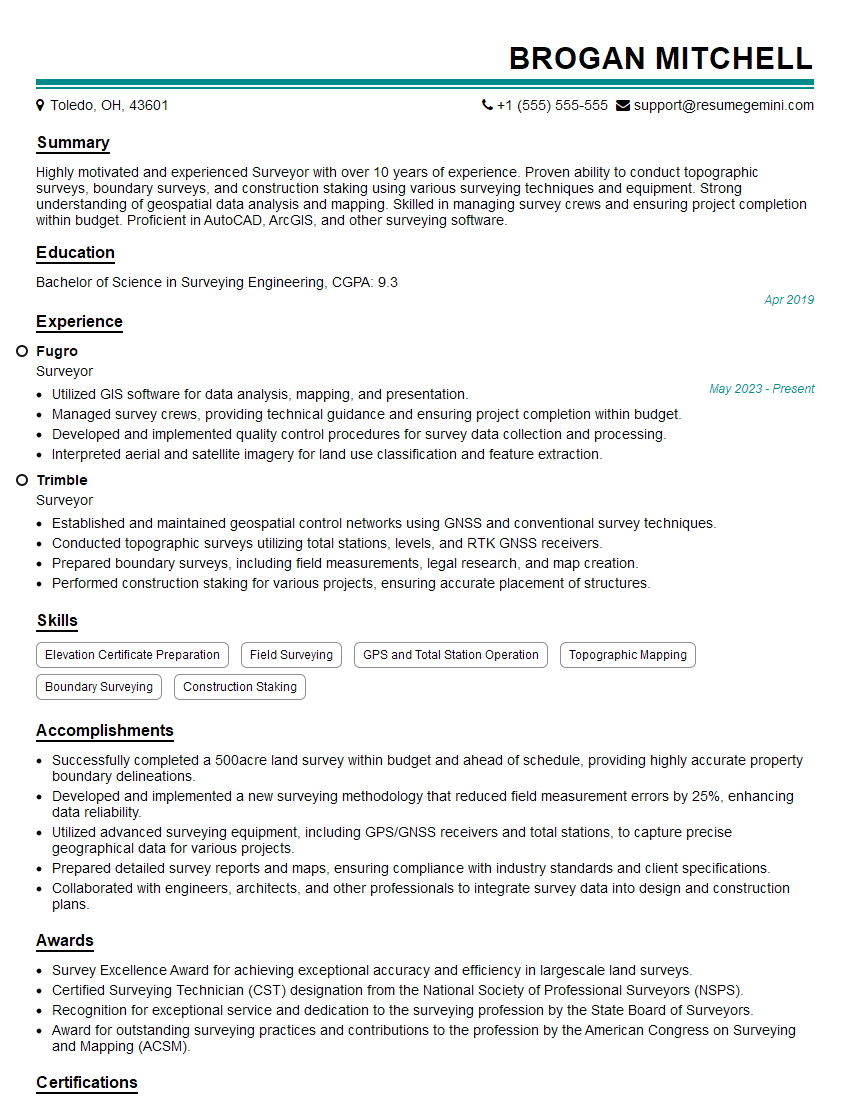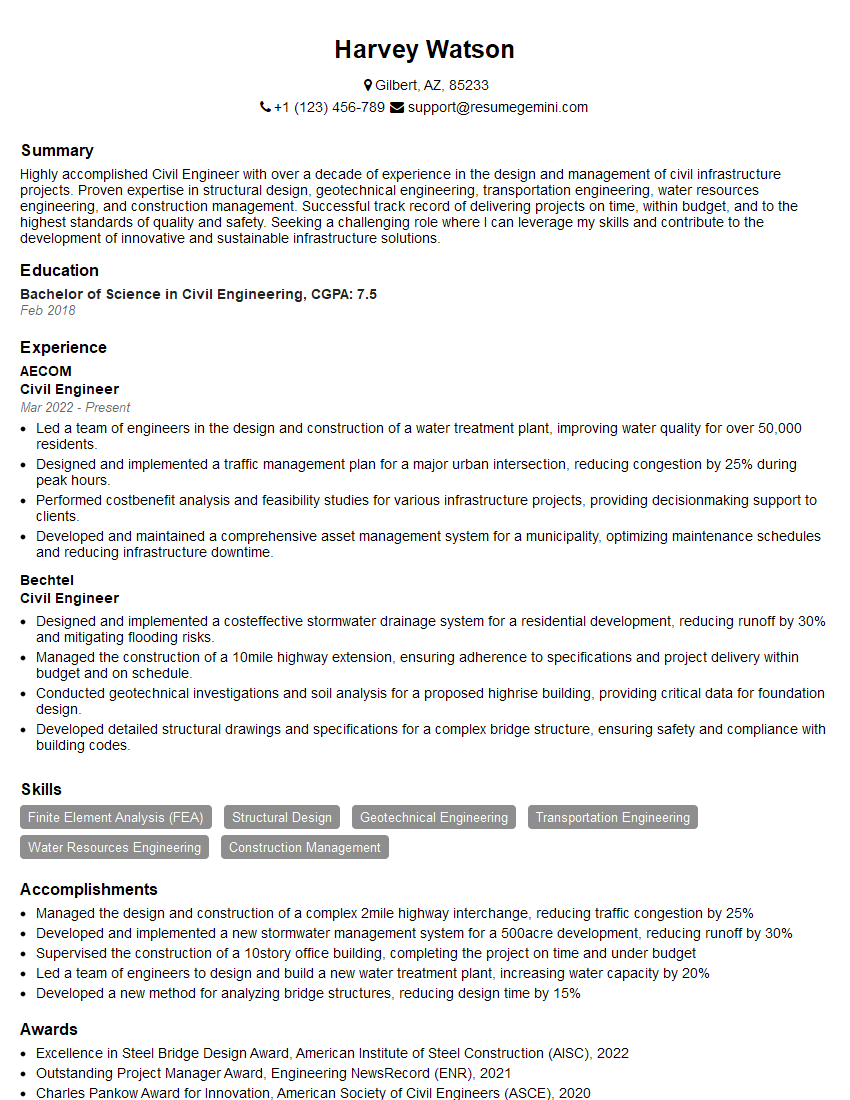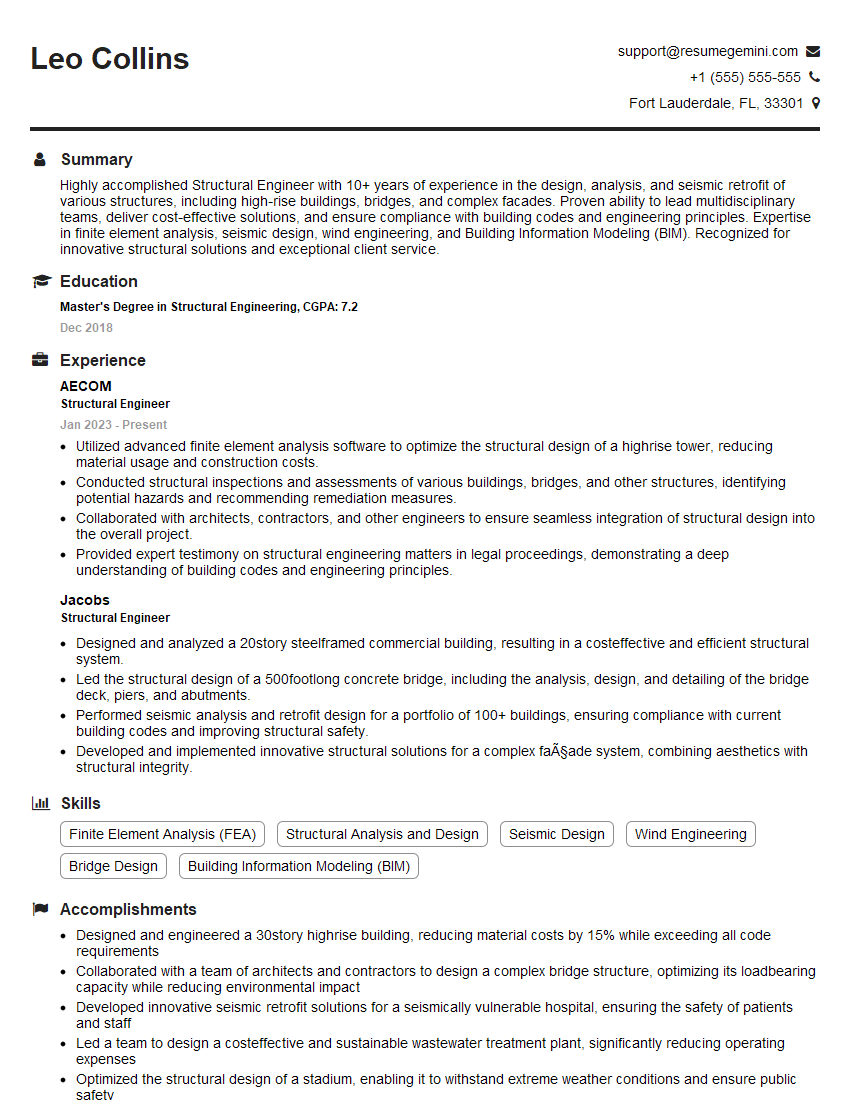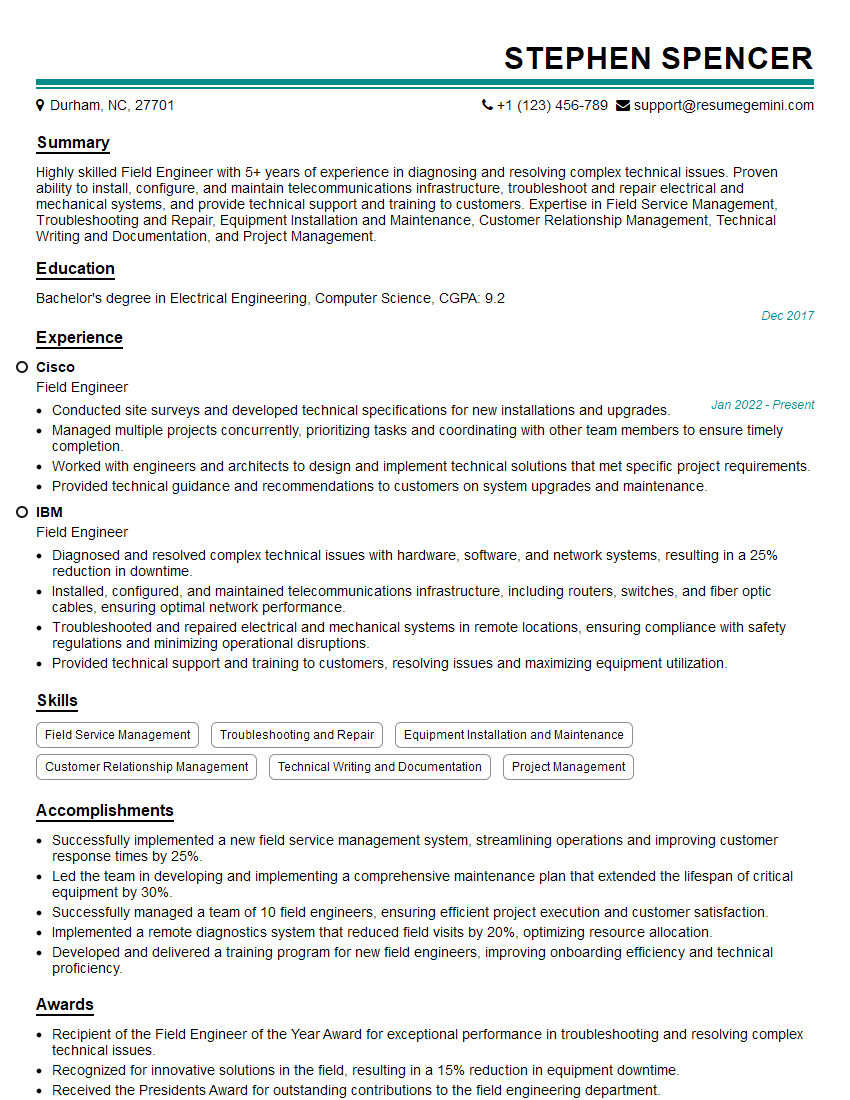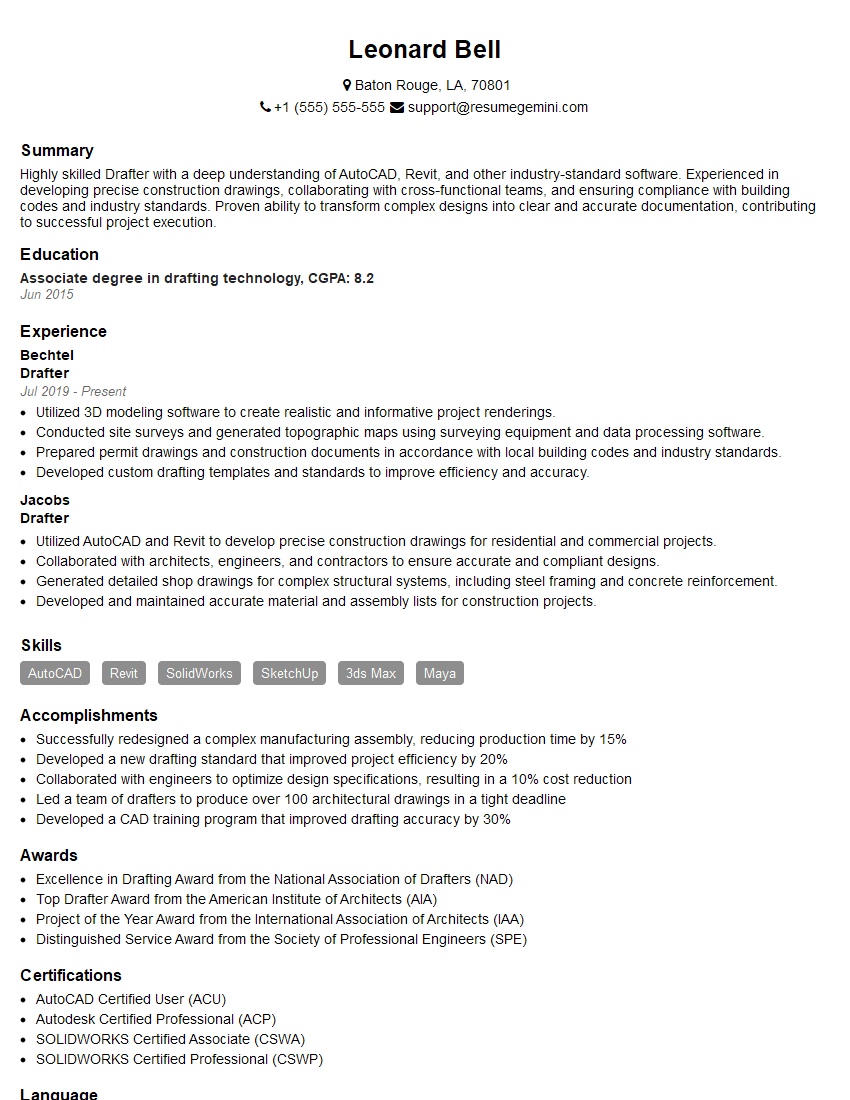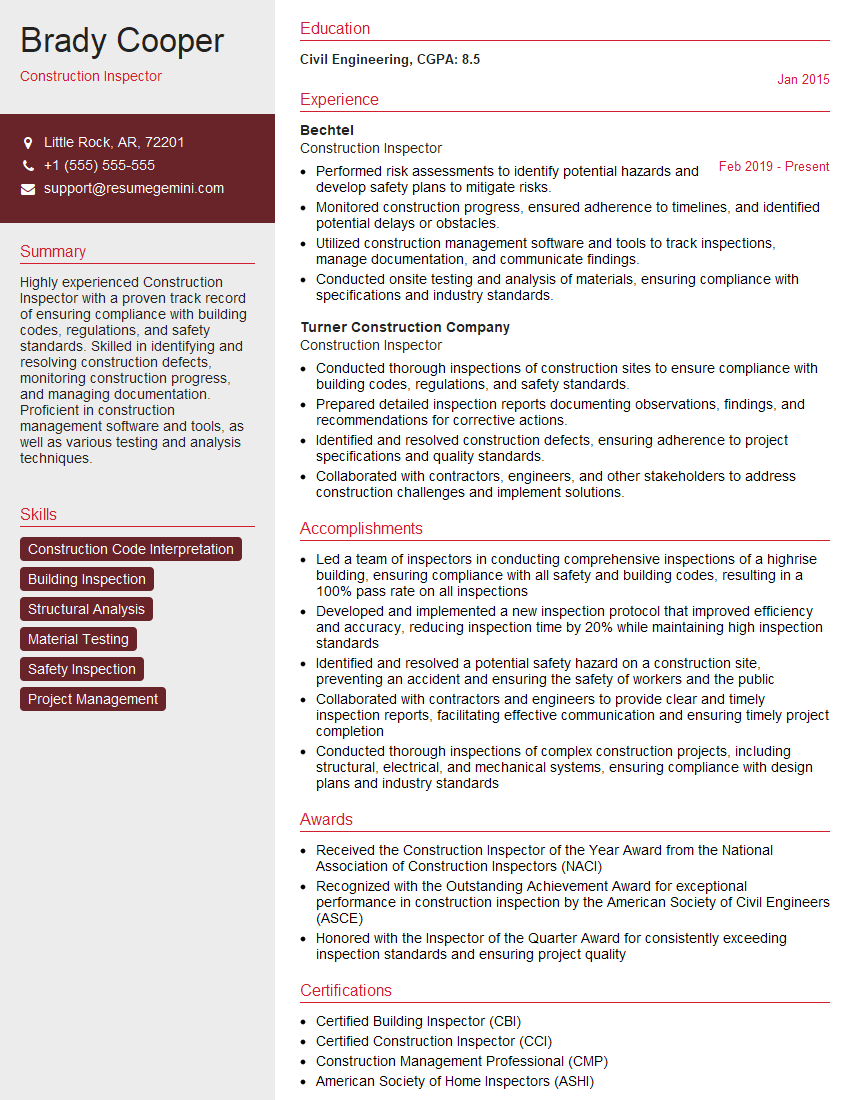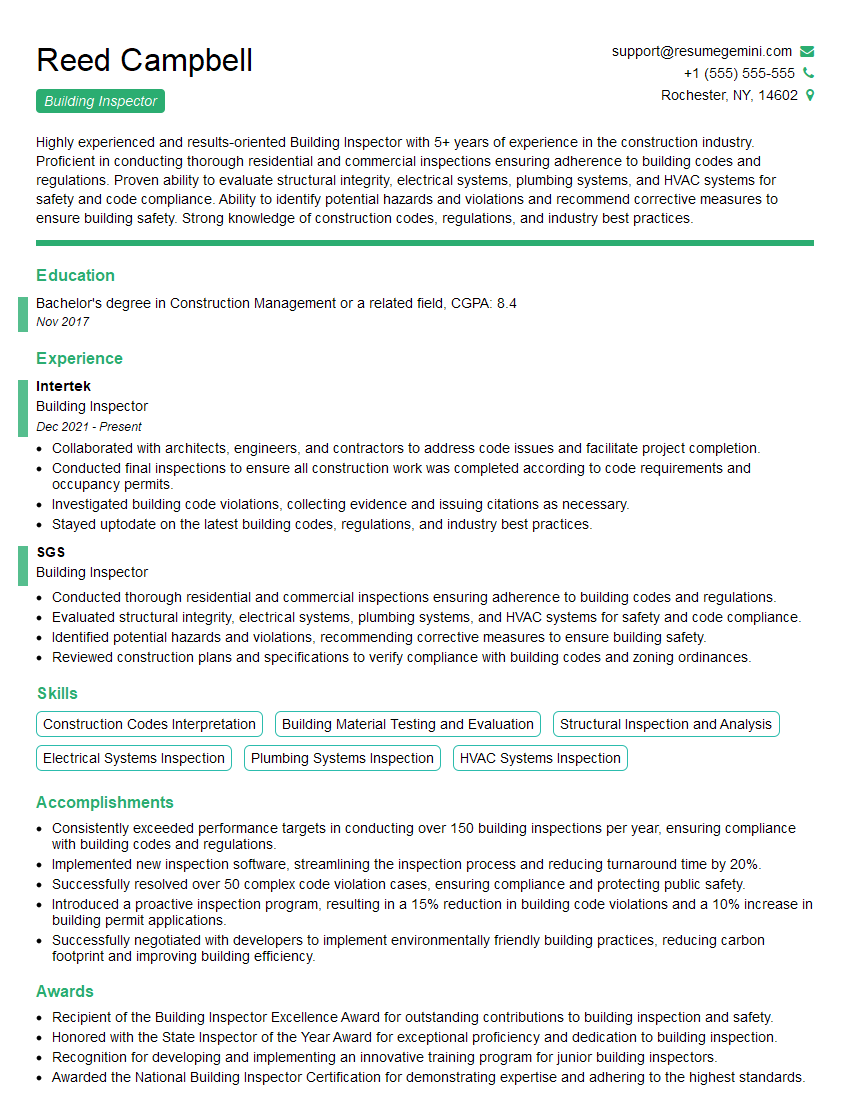Interviews are more than just a Q&A session—they’re a chance to prove your worth. This blog dives into essential Ability to read and interpret blueprints and construction plans interview questions and expert tips to help you align your answers with what hiring managers are looking for. Start preparing to shine!
Questions Asked in Ability to read and interpret blueprints and construction plans Interview
Q 1. Explain the different types of lines used on construction blueprints.
Construction blueprints utilize a variety of lines to convey different information. Think of them as a visual language. Each line type has a specific meaning, ensuring clarity and precision in the design. Here are some key examples:
- Object Lines: These are thick, solid lines defining the outlines of walls, doors, windows, and other building elements. They’re the ‘bones’ of the structure.
- Hidden Lines: Represented by short dashed lines, these indicate parts of the structure hidden from view in the current drawing. Imagine seeing a wall’s outline through a floor; these are the lines representing that concealed portion.
- Center Lines: Long and short dashed lines indicating the center of symmetrical objects like doors, windows, or circular features. They’re vital for precise measurements and symmetrical constructions.
- Dimension Lines: Thin lines with arrowheads at each end, used to show distances between elements. A measurement is usually placed above these lines.
- Extension Lines: Light lines extending from an object to meet the dimension line. They help clearly define the point being measured. These act like guides for measurement.
- Break Lines: Zigzag lines used to shorten long, repetitive elements without losing critical information. Think of this as a visual shorthand for reducing clutter.
- Section Lines (Hatching): Used to indicate a cut-away view of a building element, often showing internal construction details. This is essential to visualizing the ‘inside’ of walls or other components.
Understanding these line types is fundamental to properly interpreting any blueprint.
Q 2. How do you identify north on a blueprint?
North orientation is crucial for site planning and understanding the building’s relationship to its surroundings. Blueprints typically indicate north direction using a symbol, often a filled-in arrow or a ‘N’ labeled arrow. This symbol is usually found in the title block or a prominent location on the drawing. Sometimes, a north arrow is included in a separate legend or key.
If unsure, look for the title block – this area usually includes a legend, a scale, project name, and other vital information, including the orientation. The north symbol should be easily visible within the title block or close proximity to it. The key thing is to locate a labeled or identifiable symbol that denotes the cardinal direction.
Q 3. What are the standard symbols for walls, doors, and windows on a blueprint?
Standard symbols for walls, doors, and windows vary slightly depending on the drafting standards used, but common conventions exist. Think of these as simplified icons that represent real-world building components:
- Walls: Typically represented by thick, solid lines. Different line weights (thickness) may indicate wall type (e.g., exterior versus interior walls). The walls are usually drawn in plan view, showing the shape and layout.
- Doors: Shown using a symbol that often looks like a swing-door and sometimes includes information about its swing direction. The symbol is placed on the wall lines to show the door’s location and approximate size.
- Windows: Often represented by a simple rectangular or square symbol placed on the wall line, sometimes with a specific indication to depict casement, sliding, etc. Again, placement and size give an idea of the window’s real-world dimensions.
Always refer to the blueprint’s legend or key for confirmation. This provides a visual guide to understand all symbols used in that specific project.
Q 4. How do you interpret scales on architectural drawings?
Scales on architectural drawings are crucial for translating the drawing dimensions to real-world measurements. They indicate the ratio between the drawing’s size and the actual size of the building. For instance, a scale of 1:50 means that 1 unit on the drawing represents 50 units in reality. It’s like a miniature map of a building.
To interpret scales, identify the scale notation (e.g., 1/4″ = 1′, 1:100). This lets you convert measurements made on the drawing to real-world dimensions using simple proportions. A ruler is your key tool here. Measure on the blueprint and then apply the scale proportion for the real-world equivalent.
For example, if a wall measures 3 inches on a 1/4″ = 1′ drawing, the actual wall length is 12 feet (3 inches * 4 inches/foot = 12 feet). This is why understanding scales is paramount.
Q 5. Explain the difference between a floor plan and a section view.
Floor plans and section views provide different but complementary perspectives of a building:
- Floor Plan: A horizontal ‘slice’ through a building, showing the arrangement of rooms, walls, doors, and other features. Imagine looking down from above, ‘through’ the roof and ceilings. A floor plan gives you a top-down layout of a floor’s elements.
- Section View: A vertical ‘cut’ through the building, revealing the interior construction and the arrangement of elements in that specific plane. Think of slicing a cake; the section view is like viewing the interior of that slice of cake.
In essence, a floor plan shows the layout from above, while a section view shows the structure’s construction and height. Both are crucial for a complete understanding of the design.
Q 6. How do you identify elevations and dimensions on a blueprint?
Elevations and dimensions are essential for understanding the building’s height and spatial relationships. They’re typically represented as:
- Elevations: Drawings showing the exterior faces of the building. They indicate the building’s height, roofline, window placements, and other exterior details. They’re like external portraits of the building.
- Dimensions: Numerical values indicating distances between elements. These are almost always indicated along the dimension lines on the drawings. They include both horizontal and vertical measurements.
Finding these is straightforward: elevations are usually identified as ‘Elevation North,’ ‘Elevation South,’ etc., and dimensions are shown using dimension lines with the numerical values clearly visible. Units (feet, inches, meters, etc.) are typically specified on the blueprint.
Q 7. Describe how you would interpret a detail drawing.
Detail drawings provide enlarged, detailed views of specific building components. These are like magnified ‘close-ups’ of crucial parts of the construction. They’re essential for showing specific construction methods, assembly details, and precise dimensions of smaller components which may not be clear in the main drawings.
To interpret them, start by understanding the context: Where does the detail apply in the overall plan? Then, examine the drawing itself, focusing on the individual elements and their relationships. Look for notes and annotations that provide additional clarifications, and cross-reference with other drawings if needed. It’s like assembling a puzzle; each piece needs to fit perfectly to understand the final construction.
Q 8. How would you locate specific information (e.g., plumbing fixtures) on a set of blueprints?
Locating specific information like plumbing fixtures on blueprints involves a systematic approach. First, you need to identify the relevant drawing sheet. Blueprint sets are typically organized by discipline (e.g., architectural, structural, mechanical, electrical, plumbing) and floor level. Plumbing fixtures are usually detailed on the plumbing drawings, often denoted with a sheet number like “M-P1” (Mechanical, Plumbing sheet 1). Within the sheet, look for the legend or key which provides a list of symbols and their meanings. Plumbing fixtures are usually represented by clear symbols, and their locations are indicated with their outlines and labels. For example, a toilet might be shown as a simple outline with a ‘W.C.’ label. You’ll follow the dimension lines and notes to understand the exact placement relative to the walls and other fixtures. Think of it like a treasure map – the legend gives you the symbols, the dimensions are your coordinates, and the plan view is the terrain.
For instance, on a large complex project, you might need to cross-reference multiple sheets to fully understand the location and connection of a fixture within the entire system. A fixture located on one sheet might be connected to a drain or supply line detailed on another sheet.
Q 9. How do you use a legend or key to understand blueprint symbols?
The legend or key on a blueprint is your Rosetta Stone – it’s crucial for understanding the symbols used. It’s usually located on the drawing sheet itself, often in a corner or along a margin. The legend provides a visual list of symbols used to represent different elements of the building, such as walls, doors, windows, electrical outlets, plumbing fixtures, and structural components. Each symbol is paired with its description, often including specifications (size, type, material). For instance, a filled-in square might represent a plumbing fixture (toilet) while a smaller circle with a cross inside might represent an electrical outlet. Before tackling any drawing, always study the legend to avoid misinterpretations.
Learning to read a legend effectively can be likened to learning a new language. It takes some practice, but once you familiarize yourself with the common symbols, it becomes second nature.
Q 10. What are the common materials identified on blueprints?
Blueprints identify a wide array of common construction materials. These are typically indicated using symbols, abbreviations, or notes. Common examples include:
- Concrete: Often represented by cross-hatching or specific patterns.
- Steel: Usually shown with solid black lines and might have specifications (size and type of beam, column, etc.) annotated.
- Wood: Depicted with different line patterns to denote types of wood framing (e.g., lumber sizes).
- Masonry (Brick, Block): Represented with specific patterns or symbols indicating the type of brick or block and its size.
- Gypsum Board (Drywall): Often shown with its thickness as a note near the wall section detail.
- Insulation: Typically depicted with a specific pattern or hatching, with its type and R-value noted.
It’s important to note that the specific representation of materials can vary slightly based on the company or drafting standards used.
Q 11. How do you interpret structural details on a blueprint?
Interpreting structural details on a blueprint involves understanding the building’s skeletal system. This includes beams, columns, foundations, and other load-bearing elements. These details are often found on structural drawings, which provide sections, elevations, and details of the structural components. To interpret these details, focus on:
- Member sizes and materials: Dimensions of beams, columns, and other structural elements are clearly indicated with numerical labels. Material types (steel, wood, concrete) are also shown using symbols or notes.
- Connections: Look for details on how structural elements connect to each other (e.g., welds, bolts, connectors). These connection details ensure proper load transfer.
- Foundation details: This section shows the foundation type (e.g., slab-on-grade, basement, pile foundation), its dimensions, and the reinforcing details.
- Section views: These are cross-sections through the structure which reveal how different structural components work together to form the building framework. Think of them as slices through the building to show its inner workings.
Mastering structural details often involves experience and knowledge of structural engineering principles.
Q 12. Can you explain how to identify load-bearing walls on a blueprint?
Identifying load-bearing walls on a blueprint is essential for structural understanding. Load-bearing walls support the weight of the structure above them; they are thicker than non-load-bearing walls. Several indicators can help identify them:
- Wall thickness: Load-bearing walls are usually thicker than partition walls. This is often clearly indicated on the drawings with dimensions.
- Foundation details: Check the foundation plan; load-bearing walls usually sit on top of a foundation element directly beneath.
- Structural drawings: Detailed structural drawings will explicitly show load paths and clearly indicate which walls are load-bearing. These drawings are distinct from the architectural plans.
- Symbols and annotations: Some blueprints use specific symbols or notations to clearly mark load-bearing walls. Check the legend for any specific indications.
It’s crucial to remember to always check the structural drawings and not solely rely on the architectural drawings to make this determination, especially in complex structures. Misinterpreting this can have major consequences.
Q 13. How do you understand and interpret electrical and plumbing symbols?
Electrical and plumbing symbols are crucial elements within a blueprint set. These symbols communicate the location of various components and their interconnections. Each discipline (electrical and plumbing) has its own set of standard symbols, and it’s essential to refer to the specific legend to decipher these effectively. Plumbing symbols commonly include things like toilets, sinks, bathtubs, pipes, valves and fittings while electrical symbols include outlets, switches, light fixtures, circuit breakers, and panel boxes. Each symbol is typically very specific and should be looked up in the legend for an exact interpretation.
Consider it a type of shorthand: a small symbol in the plan view can represent a complex installation that is then further specified in a detail drawing in another sheet. Understanding these drawings effectively requires diligent cross referencing and careful attention to detail.
Q 14. How do you interpret a site plan?
A site plan is an overview of a project’s location, showing its relationship to the surrounding environment. It provides a bird’s-eye view of the property including the building’s footprint, surrounding features, and utilities. Interpreting a site plan requires attention to:
- Building location and orientation: The site plan precisely shows the building’s position on the lot and its orientation to north, south, east, and west.
- Property boundaries: The boundaries of the property are clearly marked, along with any easements or restrictions.
- Existing features: Existing buildings, trees, roads, utilities, and other site features are indicated.
- Proposed features: New construction elements, landscaping, driveways, and other improvements are shown.
- Utilities: Locations of water mains, sewer lines, electrical lines, and gas lines are often noted.
- Grading and topography: Contour lines often indicate elevation changes and assist in visualizing the terrain.
Think of a site plan as a geographical roadmap for the entire project. It provides critical information for site preparation, grading, utility hookups, and overall project layout and design.
Q 15. How would you use blueprints to identify potential construction conflicts?
Identifying potential construction conflicts on blueprints requires a meticulous review and cross-referencing of different disciplines’ work. Think of it like a complex puzzle where each piece (electrical, plumbing, HVAC, structural) must fit perfectly without clashing.
Overlapping Systems: I’d carefully examine the locations of plumbing pipes, electrical conduits, HVAC ducts, and structural elements. A common conflict is a duct running through a planned wall cavity where plumbing needs to be installed. The blueprint needs to show clear separation or coordination.
Dimensional Conflicts: I would double-check dimensions and clearances. For instance, a door swing might interfere with a planned staircase, or a window placement might conflict with a nearby structural column. This is where precise measurements and scale are crucial.
Code Violations: I’d constantly refer to building codes while reviewing. For example, insufficient clearance around a fire sprinkler might be revealed only by comparing the sprinkler layout with the placement of other elements.
Coordination Issues: Discrepancies between architectural, structural, mechanical, and electrical drawings are significant sources of conflict. A change on one drawing needs to be reflected on related drawings to avoid clash.
By systematically comparing all aspects of the blueprints, I can proactively identify and address potential conflicts before they become costly problems on-site. This is a crucial part of my role in preventing delays and ensuring a smooth construction process.
Career Expert Tips:
- Ace those interviews! Prepare effectively by reviewing the Top 50 Most Common Interview Questions on ResumeGemini.
- Navigate your job search with confidence! Explore a wide range of Career Tips on ResumeGemini. Learn about common challenges and recommendations to overcome them.
- Craft the perfect resume! Master the Art of Resume Writing with ResumeGemini’s guide. Showcase your unique qualifications and achievements effectively.
- Don’t miss out on holiday savings! Build your dream resume with ResumeGemini’s ATS optimized templates.
Q 16. How do you calculate square footage from a floor plan?
Calculating square footage from a floor plan is a fundamental skill. Imagine the floor plan as a collection of geometric shapes—rectangles, squares, triangles—that we can measure and add up.
Divide and Conquer: Break down complex floor plans into simpler shapes. For example, a room with an L-shape can be separated into two rectangles.
Measure Dimensions: Using the blueprint’s scale (typically indicated in a legend), carefully measure the length and width of each shape in feet or meters.
Area Calculation: For rectangles and squares, multiply length by width. For triangles, it’s (base * height) / 2. For irregular shapes, approximation techniques or software might be needed.
Summation: Add up the areas of all individual shapes to get the total square footage of the room or the entire floor.
Example: A rectangular room measuring 12 feet by 15 feet has an area of 180 square feet (12 ft * 15 ft = 180 sq ft).
Accuracy is paramount here. A small mistake in measurement can lead to significant errors in material estimations and project costing. I always double-check my measurements and calculations.
Q 17. How do you interpret building codes and regulations as shown on the blueprints?
Interpreting building codes and regulations on blueprints is crucial for ensuring compliance and safety. Building codes are like a rulebook that specifies minimum standards for construction. The blueprints should explicitly show compliance with these regulations.
Code References: Blueprints often include notes or symbols that directly reference specific building codes. I would consult the relevant code book (e.g., the International Building Code) to understand the meaning of these references.
Minimum Requirements: I would verify that all elements shown on the blueprints meet or exceed the minimum requirements specified by the codes, such as those related to fire safety, accessibility, structural integrity, and energy efficiency.
Special Symbols: Familiarity with standardized symbols is key. Symbols representing fire-rated materials, accessibility ramps, or specific electrical requirements are common, and understanding their implications is crucial.
Compliance Documentation: Sometimes the blueprints include specific compliance documentation, like calculations or certifications to demonstrate that the design adheres to the codes.
For instance, the minimum egress width for a corridor might be specified in the code. I’d check the blueprints to ensure that the corridor width meets or exceeds this minimum.
Q 18. How do you identify different types of foundation systems on a blueprint?
Identifying foundation systems on a blueprint involves recognizing specific architectural and structural details. The foundation is the base upon which the entire structure rests, so correctly understanding its type is paramount.
Footings: These are shown as individual elements under the foundation walls, usually indicated by their size and depth. Different footing types (spread, continuous, etc.) can be visually identified.
Foundation Walls: The walls themselves might be depicted as concrete, masonry, or other materials. The cross-section drawings reveal wall thickness and reinforcement details, offering clues to the design and load-bearing capacity.
Foundation Plans: Dedicated foundation plans often show detailed information, including pier locations (if any), the type of foundation (slab-on-grade, basement, crawlspace, pile foundation), and drainage systems.
Sections and Details: Cross-sections and detailed views provide a clearer understanding of the foundation’s composition and interaction with the soil. This is vital for recognizing things like waterproofing membranes and insulation placement.
For example, a slab-on-grade foundation will be shown as a continuous concrete slab directly on the ground, while a basement foundation includes concrete walls and a floor slab below ground level. Recognizing these visual cues accurately is a critical aspect of understanding the overall building structure.
Q 19. Explain how you would use blueprints to identify potential safety hazards.
Identifying potential safety hazards on blueprints requires a proactive approach. It’s about looking beyond the aesthetics and focusing on the things that could pose risks during construction or building occupancy.
Fall Hazards: I’d examine areas where workers might be at risk of falls, such as open pits, unprotected edges, or insufficient guardrails around elevated work areas. The blueprint needs to address these adequately, ensuring proper protection measures are integrated into the design.
Emergency Exits: Adequate and unobstructed exits are crucial. I would verify the proper size, location, and accessibility of exits to ensure safety and compliance with fire codes.
Hazardous Material Storage: The design for the storage of flammable materials, hazardous chemicals, or other potentially dangerous substances should be carefully reviewed for proper ventilation and safety measures to prevent accidents.
Structural Integrity: Assessing the structural capacity of elements is critical to prevent collapse. I’d verify proper support systems and material specifications to ensure the structure is safe under various load conditions.
Utility Locations: Correctly identifying underground utilities to prevent accidental damage during excavation is crucial for worker safety. Blueprint annotations and references to utility plans are important.
It’s all about a careful and systematic check, using the blueprints to preemptively identify and mitigate safety risks throughout the entire construction process.
Q 20. How do you use blueprints to estimate material quantities?
Estimating material quantities from blueprints is vital for accurate budgeting and efficient procurement. It’s like a shopping list for the construction project, ensuring we have exactly what we need, without excess or shortage.
Measurements: Accurate measurements from the blueprints are paramount. This involves calculating areas, volumes, and lengths of various elements, using the specified scale.
Material Specifications: The blueprints specify the materials to be used—concrete, lumber, steel, etc. I would use this information to determine the appropriate units of measurement (cubic yards of concrete, board feet of lumber).
Waste Factor: It’s crucial to include a waste factor to account for material loss due to cutting, breakage, or other factors. This factor is typically determined based on experience and material type.
Quantity Calculations: I would then use the measured quantities, material specifications, and the waste factor to perform calculations to determine the total amount of each material needed.
For instance, to calculate the concrete needed for a foundation, I’d multiply the volume of the foundation (calculated from blueprint dimensions) by the concrete’s density. The waste factor would then be added to the final quantity, assuring sufficient supply.
Q 21. How do you use blueprints in conjunction with other project documents?
Blueprints don’t exist in isolation; they are part of a larger project document set. Think of them as the central visual component, needing to be integrated with other documents for a complete understanding.
Specifications: The project specifications provide detailed written descriptions of materials, construction methods, and quality standards. I’d cross-reference the specifications with the blueprints to ensure consistency.
Schedules: Construction schedules outline the timeline for different phases of the project. I’d use the blueprints to understand the sequencing of tasks and resource allocation, ensuring everything aligns.
Shop Drawings: Shop drawings provide detailed fabrication plans for specific components. I’d compare shop drawings with the blueprints to verify that the manufactured components will fit correctly and meet the design intent.
Engineering Calculations: Structural, mechanical, or electrical calculations support the design shown on the blueprints. I would reference these to verify the design’s feasibility and structural integrity.
By integrating all documents, I can create a complete, accurate, and holistic understanding of the project, avoiding discrepancies and improving communication among the project team.
Q 22. Describe your experience working with different blueprint formats (e.g., PDF, CAD).
Throughout my career, I’ve worked extensively with various blueprint formats, primarily PDF and CAD (Computer-Aided Design) files. PDFs are commonly used for distribution and archiving, offering a readily accessible, standardized format for viewing plans. However, for detailed work and revisions, CAD files are indispensable. My experience encompasses navigating both 2D and 3D CAD models, using software like AutoCAD and Revit. I’m proficient in extracting relevant information from both, understanding the nuances of layering, annotations, and different drawing scales within each. For instance, I’ve used PDFs to review preliminary designs and collaborate with clients, while relying on CAD files for detailed measurements, precise analysis, and making necessary modifications during the construction process. The ability to seamlessly transition between these formats is crucial for effective project management.
Q 23. How do you handle discrepancies or errors found on a blueprint?
Discovering discrepancies or errors on blueprints demands a systematic approach. My first step is to meticulously verify the error. Is it a simple typographical error, a conflict between different drawings, or a more significant design flaw? I then cross-reference the conflicting information with other drawings, specifications, and relevant documents. If the error is minor (like a mislabeled dimension), I might make a note and proceed, assuming the discrepancy is insignificant. However, for major inconsistencies, I would immediately flag the issue and initiate a discussion with the design team or project architect. I carefully document all discrepancies, including my assessment, proposed solutions (if any), and the resolution reached. For example, I once noticed a conflict between the electrical plan and the plumbing plan where a conduit was directly intersecting a pipe. I documented the problem, presented it to the engineer, and we worked collaboratively to relocate the conduit, thereby preventing a potential construction issue.
Q 24. Explain your process for interpreting complex or detailed blueprints.
Interpreting complex blueprints requires a methodical approach. I begin by thoroughly understanding the project’s scope and objectives. Then, I systematically review all related drawings, starting with the general site plan and progressively moving to detailed drawings like floor plans, elevations, sections, and details. I pay close attention to the drawing scales, symbols, notations, and legends to ensure accuracy. I use layering techniques in CAD software to isolate specific elements to facilitate analysis. If necessary, I create supplementary sketches and diagrams to clarify my understanding. For example, on a recent project featuring a complex multi-level building, I created a 3D model from the 2D drawings to visualize the spatial relationships between different systems. This helped me identify potential clashes and optimize design decisions.
I often break down complex drawings into smaller, manageable parts to aid comprehension. This allows me to focus on one system at a time—plumbing, electrical, structural, etc.—to fully grasp the intricacy before moving to the next. This systematic approach improves accuracy and reduces mistakes significantly.
Q 25. Describe a time you had to solve a problem using blueprint information.
During the construction of a high-rise building, a discrepancy arose between the structural drawings and the architectural renderings regarding the placement of a load-bearing column. The architectural rendering showed the column in a location that would have encroached on a planned elevator shaft, making the design infeasible. By carefully comparing the revised structural drawings with the original plans and architectural renderings, I identified the source of the discrepancy – a minor error in the initial CAD file. I presented my findings to the project manager, and we collaborated with the structural engineer to correct the blueprint and avoid costly rework during the construction phase. This highlighted the critical importance of precise blueprint interpretation and communication among the different disciplines involved in a construction project.
Q 26. How do you stay updated on changes and revisions to construction blueprints?
Staying updated on blueprint revisions is paramount. I maintain regular communication with the design team and the project manager, typically through email and project management software (e.g., PlanGrid, BIM 360). Many projects utilize cloud-based systems where revisions are automatically updated, providing real-time access to the latest versions. Additionally, I always check for revision marks directly on the blueprints, noting dates, descriptions of changes, and who issued them. If working with paper prints, I make sure to clearly mark any changes with revision numbers and dates, to ensure I’m always using the latest information.
Q 27. How do you ensure you are using the most current version of the blueprints?
To guarantee the use of the most current blueprints, I adhere to a rigorous version control system. For digital blueprints, I make sure that I am always accessing the project files from the central repository, such as a shared network drive or cloud-based storage. I carefully review the revision numbers and dates to confirm I’m working with the latest version. For paper blueprints, I maintain a log of all received revisions, noting their dates and ensuring that the most recent version is prominently displayed and readily accessible. This meticulous approach minimizes the risk of errors and ensures that all work is based on the most accurate and up-to-date information.
Key Topics to Learn for Ability to read and interpret blueprints and construction plans Interview
- Blueprint Fundamentals: Understanding scales, symbols, and legends used in architectural and engineering drawings. This includes recognizing different line types and their significance (e.g., object lines, hidden lines, center lines).
- Interpreting Floor Plans: Identifying walls, doors, windows, fixtures, and other building components. Practicing calculating room dimensions and areas from plan views.
- Elevation and Section Views: Understanding how these drawings depict the vertical dimensions and internal structures of a building. Analyzing details like wall heights, roof pitches, and foundation designs.
- Working Drawings and Specifications: Differentiating between various types of construction drawings (e.g., structural, electrical, plumbing) and understanding how they relate to project specifications.
- Practical Application: Visualizing a 3D model from 2D drawings. Identifying potential conflicts or inconsistencies within the plans. Explaining how changes to one part of the plan might affect other areas.
- Material Identification: Recognizing symbols and notations for different building materials (e.g., concrete, wood, steel) on blueprints.
- Problem-Solving: Describing your approach to identifying and resolving discrepancies or ambiguities within a set of construction plans. Demonstrating your ability to interpret complex information effectively.
- Construction Sequencing: Understanding the logical order of construction phases as depicted (or implied) in the blueprints and specifications.
Next Steps
Mastering the ability to read and interpret blueprints and construction plans is crucial for career advancement in the construction and engineering industries. A strong understanding of these skills demonstrates your technical competency and problem-solving abilities, leading to increased opportunities and higher earning potential. To maximize your job prospects, focus on creating an ATS-friendly resume that highlights your skills and experience effectively. ResumeGemini is a trusted resource to help you build a professional and impactful resume. Examples of resumes tailored to showcasing expertise in blueprint reading and interpretation are available for your review – use them to inspire your own.
Explore more articles
Users Rating of Our Blogs
Share Your Experience
We value your feedback! Please rate our content and share your thoughts (optional).
What Readers Say About Our Blog
Hi, I’m Jay, we have a few potential clients that are interested in your services, thought you might be a good fit. I’d love to talk about the details, when do you have time to talk?
Best,
Jay
Founder | CEO
